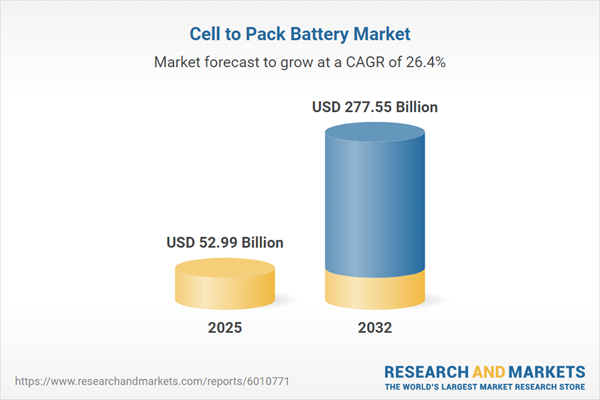Speak directly to the analyst to clarify any post sales queries you may have.
The Cell to Pack Battery Market is rapidly evolving as automakers and energy stakeholders accelerate electrification strategies and seek solutions that provide greater efficiency, safety, and adaptability in battery systems. This report provides actionable intelligence tailored for leadership teams evaluating next-generation energy storage investments.
Market Snapshot: Cell to Pack Battery Market Size and Growth
The Cell to Pack Battery Market grew from USD 42.49 billion in 2024 to USD 52.99 billion in 2025. It is expected to continue growing at a CAGR of 26.43%, reaching USD 277.55 billion by 2032.
Scope & Segmentation of the Cell to Pack Battery Market
The report explores the full value chain and the evolving structure of cell-to-pack architectures, presenting a detailed analysis of the supply landscape, technology adoption, and demand-side factors. The research investigates adoption patterns and performance characteristics across market segments and regions:
- Forms: Cylindrical, Pouch, Prismatic
- Battery Type: Lead-Acid, Lithium Ion, Lithium Iron Phosphate, Lithium Sulphur, Nickel Manganese Cobalt, Nickel Metal Hydride
- Components: Battery Management System, Cell, Coolant, Housing, Switches & Fuses
- Propulsion Type: Battery Electric Vehicles, Plug-in Hybrid Electric Vehicles
- Vehicle Type: Commercial Vehicle, Passenger Vehicle
- End User: Aftermarket, OEMs
- Regions: Americas, Europe Middle East Africa, Asia-Pacific
- Countries: Including the United States, Canada, Brazil, United Kingdom, Germany, China, India, Japan, and others
- Companies Covered: From global leaders like BYD Motors Inc., Panasonic Industry Co., Ltd., Samsung SDI Co., Ltd. to specialized providers such as Custom Power and IONETIC Limited
Key Takeaways for Senior Decision-Makers
- Direct cell-to-pack integration increases energy density, while reducing complexity in battery assembly and enabling streamlined design adaptations.
- Collaborations between automakers, cell producers, and materials suppliers are expanding capabilities, supporting the transition to flexible manufacturing models.
- Enhanced battery management systems with embedded sensors provide visibility into individual cell performance, supporting predictive maintenance and operational efficiency.
- Sustainability is steering material sourcing and manufacturing methods, with recycled content and low-cobalt chemistries building competitive positioning amid tightening compliance frameworks.
- Diversification of the supply base and localized production investments are emerging as risk-mitigation responses to policy and trade volatility.
- Advanced thermal management technologies, such as phase-change materials and integrated coolant pathways, address stringent safety requirements and lifecycle expectations.
Impact of US Tariffs on Cell-to-Pack Manufacturing and Trade
Recent U.S. tariffs have introduced significant shifts, affecting cost structures and global supply strategies in the Cell to Pack Battery Market. Manufacturers are expanding local production to offset tariff impacts and are seeking new contract terms, sparking closer alignment between North American automakers and cell providers. Shifting trade routes and evolving sourcing models highlight the need for supply chain agility, while industry groups pursue ongoing policy engagement to balance program momentum with regulatory changes.
Methodology & Data Sources
This report blends comprehensive secondary research, structured stakeholder interviews, and on-site facility assessments. Data triangulation ensures validity, utilizing supplier surveys, regulatory filings, patent databases, and benchmarking of leading global players. Statistical process controls inform best-practice automation recommendations in line with industry 4.0 standards.
Why This Report Matters: Strategic Benefits for Decision-Makers
- Clear segmentation insights enable tailored market entry and product alignment, supporting targeted investment decisions and risk management.
- Data-driven perspectives on technology, supply chain dynamics, and regulatory initiatives inform capital planning and operational roadmaps.
The report equips senior leaders with a nuanced understanding of evolving battery architectures, enabling agile responses to current and future industry challenges.
Conclusion
Cell-to-pack technology is reshaping the battery market through increased efficiency, enhanced safety, and scalable innovation. Strategic planning founded on robust market intelligence will be vital for organizations aiming to secure sustained competitiveness in the advanced battery sector.
Additional Product Information:
- Purchase of this report includes 1 year online access with quarterly updates.
- This report can be updated on request. Please contact our Customer Experience team using the Ask a Question widget on our website.
Table of Contents
3. Executive Summary
4. Market Overview
7. Cumulative Impact of Artificial Intelligence 2025
Companies Mentioned
The companies profiled in this Cell to Pack Battery market report include:- Alexander Battery Technologies
- AZL Aachen GmbH
- BYD Motors Inc.
- Cell Pack Solutions Ltd.
- Chroma ATE Inc.
- Contemporary Amperex Technology Co., Limited
- Custom Power
- Epec, LLC
- Genuine Power
- Henkel AG & Co. KGaA
- Hioki E.E. CORPORATION
- IONETIC Limited
- LG Energy Solution Ltd.
- Microvast Holdings, Inc.
- NEC Corporation
- Nissan Motor Co., Ltd.
- Panasonic Industry Co., Ltd.
- Plethora Power Pvt. Ltd.
- Proterra Inc.
- RRC power solutions Ltd.
- Samsung SDI Co., Ltd.
- SK innovation Co., Ltd.
- Sunwoda Electronic Co., Ltd.
- Tenergy Corporation
- Wardwizard Innovations & Mobility Ltd.
- WS Technicals A/S
Table Information
| Report Attribute | Details |
|---|---|
| No. of Pages | 188 |
| Published | November 2025 |
| Forecast Period | 2025 - 2032 |
| Estimated Market Value ( USD | $ 52.99 Billion |
| Forecasted Market Value ( USD | $ 277.55 Billion |
| Compound Annual Growth Rate | 26.4% |
| Regions Covered | Global |
| No. of Companies Mentioned | 27 |









